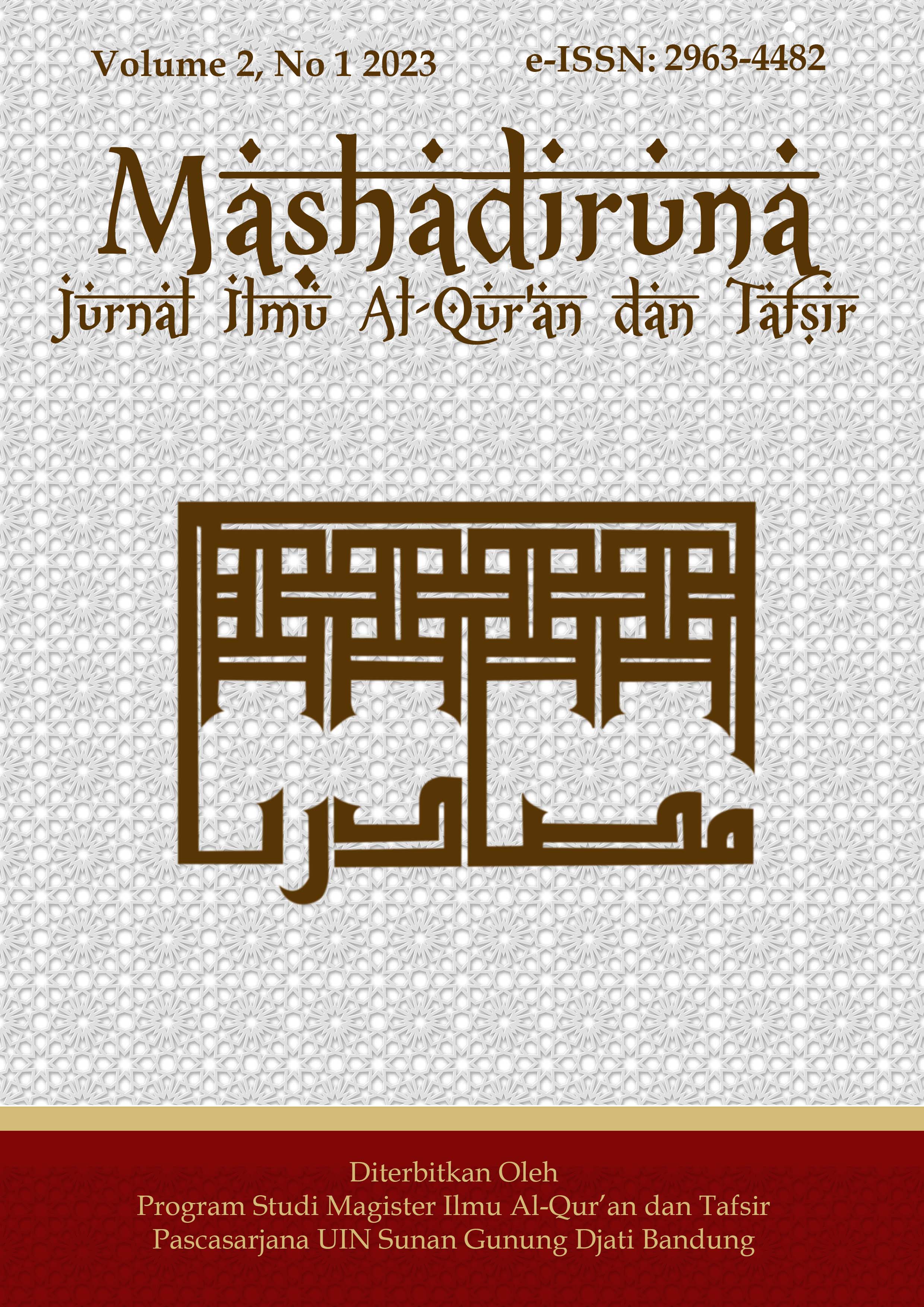Abu Thanâ' Shihâbuddîn Al-Alûsî's Interpretation of the Self-Harm (Ẓālim Li Nafsih) Verses
DOI:
https://doi.org/10.15575/mjiat.v4i1.43832Keywords:
Self-harm, Zalim Li Nafsih, Al-Alusi, Islamic PerspectiveAbstract
This study explores Abu Thanâ' Shihâbuddîn Al-Alûsî's interpretation of Qur'anic verses addressing self-harm (ẓālim li nafsih) and its relevance to the modern phenomenon of self-inflicted harm. Using a qualitative, descriptive-analytical method, the research examines Al-Alûsî's tafsir in Rūh al-Ma'ānī, particularly regarding verses such as Qs. Al-Baqarah: 195, Qs. Ali-Imran: 117, and others. Al-Alûsî interprets ẓālim li nafsih as actions violating divine commands, encompassing spiritual, moral, and physical dimensions. He emphasizes that such acts result in self-inflicted harm both in this world and the hereafter. The research draws parallels between ẓālim li nafsih and self-harm, illustrating how the latter reflects a crisis of spirituality and morality. Al-Alûsî highlights the importance of repentance, spiritual reflection, and maintaining a strong relationship with Allah SWT to heal spiritual wounds caused by self-harm. His interpretation underscores the Qur'an's guidance for addressing internal struggles through a holistic approach combining spiritual, social, and moral support. The study concludes that Al-Alûsî's insights provide a meaningful framework for understanding and addressing self-harm within an Islamic context, offering hope and a path to redemption for individuals affected by this issue.
References
‘Abbâs Mahmud al-‘Aqad. (1974). Al-Insân fî Al-Qur`ân. (Beirut, Dȃr al-Kutub al-Lubnâniy, 1974).
Abbas al-Azzawi. (1954). Dzikrâ Abî al-Tsanâ al-Alûsî. Bagdad: Mathba’ah al-Shalihiyyah.
Abd al-Hamid Muhsin (1968). Al-Alûsî Mufassiran. Baghdad: Mathba’ah al-Ma’arif .
Abdul Majid Abdul Salim al-Muhtasibb. (1973). Ittijâhât al-Tafsîr al-‘Ashr al-Hadîts. Beirut: Dar al-Fikr.
Abi Muhammad Abd ar-Rahman ar-Razi Ibnu Abi Hatim. (1997). Tafsir al-Qur'an al-'azim. Beirut: Darul Kutub al-Ilmiyah.
Abu Bakar Ahmad al-Razi al-Jassas. (1993). Ahkam al-Qur'an. Beirut: Dar al-Fikr
Abu Ja'far Muhammad bin Jarir Ath-Thabari. (1999). Jami’ Al Bayan Fi Ta’wil Al Qur’an Juz 30 . Beirut: Dar al-Kitab al-Ilmiyah.
Abul Qosim Al-Husain bin Muhammad Ar-Roghib Al-Ashfahani. (2003). Al Mufradat Fi Gharib Al-Qur'an. Kairo: Al-Maktabah At-Taufikiyah.
Al-Hafizh Abu Bakr Ahmad bin al-Husain bin ‘Ali bin Musa al-Khasrujardi al-Baihaqi. (T.t). al-Jami’ li Syu’abi al-Iman. Riyadh: Maktabah Ibn Rusyd.
Ali Hasan al-Arid. (1974). Sejarah dan Metodologi Tafsir, terjemah Ahmad Akram. Jakarta: CV. Raja Grafindo Persada.
American Psychiatric Association. (2013). Diagnostic and Statistical Manual of Mental Disorders (5th ed.). Washington DC: American Psychiatric Publishing.
Baharuddin HS, Corak Tafsir Ruh Al-Ma‟ani Karya Al-Alusi: Telaah terhadap AyatAyat Pendektan Isyari, Desertasi, (Jakarta, UIN Jakarta, 2004).
Fakhruddin Ar-Razi. Pengarang. (2012). Tafsir al-kabir (mafatih al-ghaib). Kairo: Dar el-hadith.
Indah Sari Dewi Zulkifli, dkk. (2024). Eksplorasi pengalaman dan dinamika coping pada korban Nonsuicide Self-Injury.Psychological Journal: Science and Practice 2024, Vol 4(1).
Jalaluddin Al-Suyuthi. (1994). Tafsir Al-Durr Al-Mantsur Fi Tafsir Al-Ma’tsur, Bairut: Darr al-Fikr.
Klonsky, E. D., May, A. M., & Glenn, C. R. (2013). The Relationship Between Nonsuicidal SelfInjury and Attempted Suicide: Converging Evidence from Four Samples. 122(1), 231–237. https://doi.org/10.1037/a0030278
Komaruddin Hidayat. (2008). Psikologi Ibadah. Jakarta: Serambi Ilmu Semesta.
Liana Spytska. (2004). Anxiety and depressive personality disorders in the modern world, Acta Psychologica, Volume 246, ISSN 0001-6918, https://doi.org/10.1016/j.actpsy.2024.104285.
Lubis, Irma Rosalinda. 2020. “Gambaran Kesepian Pada Remaja Pelaku Self-Harm.†Jurnal PJurnal Penelitian Dan Pengukuran Psikologi 9(April):14–21.
Mahmud al-Sa’id al-Tantawi. (1989). Manhaj al-Alusi Rûẖ al-Ma’âni fî Tafsîr al-Qur’ân al-Azîm wa aSab’u al-Masânî. Kairo: Al-Majalis al-A’la li al-Islamiyyah.
Mahmud bin Umar bin Muhammad az-Zamakhsyari. (1995). Tafsir al-Kasyaf 'an Haqaiq Ghawamidh at-Tanzil wa 'Uyun Aqawil fi Wujuh at-Tanzil. Beirut: Dar al-Kutub al-'Ilmiyah.
Maizzuddin. (2014). Perspektif Al-Qur’an Tentang Manusia Dan Kezaliman . Banda Aceh: Fakultas Ushuluddin. Universtas Islam Negeri (UIN) Ar-Raniry.
Masdain Rifa‘I (2014). Klarifikasi Al-Alusi Terhadap Ayat-Ayat Yang Terkesan Kontradiktif. Tesis. Jakarta: PTIQ.
Muhammad Ali Ayazy . (1414 H). Al-Mufassiruûn, Hayâtunâ wa Manhâjuhum. Teheran: Muassasah al-Taba’ah.
Muhammad Faisal Hamdani. (2015). Studi Naskah Tafsir Ruh Al-Maani Karya Al-Alusi. Jurnal Tanzimat 20 tahun XV.
Muhammad Yusuf dkk. (2004). Studi Kitab Tafsir Menyuarakan Teks Yang Bisu. Yogyakarta:Teras.
Nisaa Baihaqi, N. . (2022). Karakteristik Tafsir Ruh Al-Ma’ani. Al Muhafidz: Jurnal Ilmu Al-Qur’an Dan Tafsir, 2(2), 115-130. https://doi.org/10.57163/almuhafidz.v2i2.33.
Rijal Ali. (2021). Tafsir Al-Qur`An Dengan Pendekatan Interdisipliner Dan Multidisipliner. Yogyakarta: Zahir Publishing.
Syekh Mani’ Abdul Halim Mahmud. (2000). Manâhijul Mufassirîn. Kairo: Darul Kutub al-Mishri.
Syekh Muhammad Husein adz-Dzahabi. (T.t). At-Tafsîr wal Mufassirûn. Kairo: Maktabah Wahbah.
Syihabuddin Mahmud bin Abdullah Al-Husaini Al-Alusi. (T.t). Ruhul Ma'ani wa Sab'a Matsani Juz 2. Beirut: Muassasah Ar-Risalah.
Umar Ridha Kahhalah. (1986). Al-Mustadrâk ala Mu’jam al-Muallifîn. Beirut: Muassasah arRisalah.
Downloads
Published
Issue
Section
License
Copyright (c) 2025 Ilma Amalia, Edi Komarudin, Eni Zulaiha

This work is licensed under a Creative Commons Attribution-ShareAlike 4.0 International License.
Authors who publish with this journal agree to the following terms:
- Authors retain copyright and grant the journal right of first publication with the work simultaneously licensed under a Creative Commons Attribution License that allows others to share the work with an acknowledgment of the work's authorship and initial publication in this journal.
- Authors are able to enter into separate, additional contractual arrangements for the non-exclusive distribution of the journal's published version of the work (e.g., post it to an institutional repository or publish it in a book), with an acknowledgment of its initial publication in this journal.
- Authors are permitted and encouraged to post their work online (e.g., in institutional repositories or on their website) prior to and during the submission process, as it can lead to productive exchanges, as well as earlier and greater citation of published work (See The Effect of Open Access).
